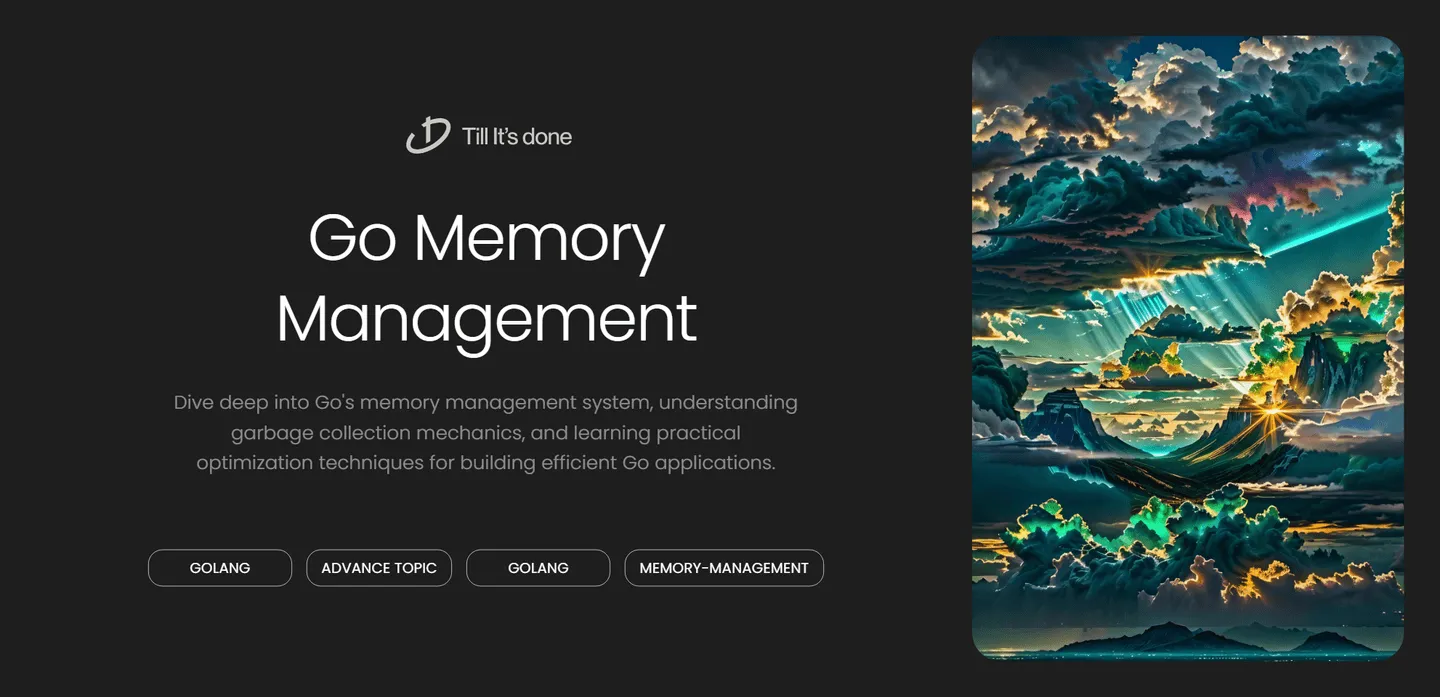- Services
- Case Studies
- Technologies
- NextJs development
- Flutter development
- NodeJs development
- ReactJs development
- About
- Contact
- Tools
- Blogs
- FAQ
Go Memory Management: GC & Optimizations

Understanding Go Memory Management: Garbage Collection and Optimizations

Memory management is one of the most crucial aspects of any programming language, and Go takes a unique approach that balances performance with developer convenience. In this deep dive, we’ll explore how Go handles memory management and discover ways to optimize your applications.
The Fundamentals of Go’s Memory Management
Go utilizes a tricolor mark-and-sweep garbage collector, which runs concurrently with your application code. Unlike traditional garbage collectors that require stopping the entire program (known as “stop-the-world” pauses), Go’s garbage collector is designed to minimize these pauses while maintaining high performance.

Memory Allocation in Go
Go’s memory allocator works on two levels:
- Stack Allocation: For small, fixed-size objects with a clear lifetime
- Heap Allocation: For larger or variable-sized objects, or when the compiler can’t determine an object’s lifetime
Let’s look at a practical example of how Go decides where to allocate memory:
func example() string { x := "local variable" // Stack allocated y := make([]int, 1000) // Heap allocated return process(x, y)}Understanding Go’s Garbage Collector
The garbage collector in Go uses a concurrent mark-and-sweep algorithm with three main phases:
- Mark Setup (STW)
- Marking (Concurrent)
- Sweep (Concurrent)

Optimization Techniques
To help your applications perform better, consider these optimization strategies:
- Object Pooling:
var pool = sync.Pool{ New: func() interface{} { return make([]byte, 1024) },}- Preallocating Slices:
data := make([]int, 0, expectedSize)- Minimize Allocations:
// Preferreds := strings.Builder{}s.WriteString("Hello")s.WriteString(" World")
// Instead ofs := "Hello" + " World"Performance Monitoring and Debugging
Go provides excellent tools for monitoring garbage collection and memory usage:
import "runtime/debug"
func init() { debug.SetGCPercent(100) // Adjust GC frequency}The GOGC environment variable can also be used to tune garbage collection frequency:
GOGC=50 ./myapp # More frequent GCGOGC=200 ./myapp # Less frequent GCBest Practices for Memory Optimization
- Use stack allocation when possible
- Avoid unnecessary memory allocation in hot paths
- Consider using sync.Pool for frequently allocated objects
- Profile your application using Go’s built-in tools
- Monitor GC patterns in production

Remember that premature optimization is the root of all evil. Always profile first to identify real bottlenecks before implementing optimizations. Go’s memory management system is highly sophisticated and works well for most applications out of the box.
By understanding these concepts and applying them thoughtfully, you can create efficient and performant Go applications while letting the garbage collector handle most of the heavy lifting for you.
 สร้างเว็บไซต์ 1 เว็บ ต้องใช้งบเท่าไหร่? เจาะลึกทุกองค์ประกอบ website development cost อยากสร้างเว็บไซต์แต่ไม่มั่นใจในเรื่องของงบประมาณ อ่านสรุปเจาะลึกตั้งแต่ดีไซน์, ฟังก์ชัน และการดูแล พร้อมตัวอย่างงบจริงจาก Till it’s done ที่แผนชัด งบไม่บานปลายแน่นอน
สร้างเว็บไซต์ 1 เว็บ ต้องใช้งบเท่าไหร่? เจาะลึกทุกองค์ประกอบ website development cost อยากสร้างเว็บไซต์แต่ไม่มั่นใจในเรื่องของงบประมาณ อ่านสรุปเจาะลึกตั้งแต่ดีไซน์, ฟังก์ชัน และการดูแล พร้อมตัวอย่างงบจริงจาก Till it’s done ที่แผนชัด งบไม่บานปลายแน่นอน  Next.js สอน 14 ขั้นตอนเบื้องต้น: สร้างโปรเจกต์แรกใน 30 นาที เริ่มต้นกับ Next.js ใน 14 ขั้นตอนเพียงแค่ 30 นาที พร้อม SSR/SSG และ API Routes ด้วยตัวอย่างโค้ดง่าย ๆ อ่านต่อเพื่อสร้างโปรเจ็กต์แรกได้ทันทีที่นี่
Next.js สอน 14 ขั้นตอนเบื้องต้น: สร้างโปรเจกต์แรกใน 30 นาที เริ่มต้นกับ Next.js ใน 14 ขั้นตอนเพียงแค่ 30 นาที พร้อม SSR/SSG และ API Routes ด้วยตัวอย่างโค้ดง่าย ๆ อ่านต่อเพื่อสร้างโปรเจ็กต์แรกได้ทันทีที่นี่  วิธีสมัคร Apple Developer Account เพื่อนำแอปขึ้น App Store ทีละขั้นตอน อยากปล่อยแอปบน App Store ระดับโลก มาอ่านคู่มือสมัคร Apple Developer Account พร้อมเคล็ดลับ TestFlight และวิธีอัปโหลดที่ง่ายในบทความเดียวนี้ได้เลย
วิธีสมัคร Apple Developer Account เพื่อนำแอปขึ้น App Store ทีละขั้นตอน อยากปล่อยแอปบน App Store ระดับโลก มาอ่านคู่มือสมัคร Apple Developer Account พร้อมเคล็ดลับ TestFlight และวิธีอัปโหลดที่ง่ายในบทความเดียวนี้ได้เลย  TypeScript Interface คืออะไร? อธิบายพร้อมวิธีใช้และข้อแตกต่างจาก Type เรียนรู้วิธีใช้ TypeScript Interface เพื่อสร้างโครงสร้างข้อมูลที่ปลอดภัยและเข้าใจง่าย พร้อมเปรียบเทียบข้อดีข้อแตกต่างกับ Type ที่คุณต้องรู้ ถูกรวมเอาไว้ในบทความนี้แล้ว
TypeScript Interface คืออะไร? อธิบายพร้อมวิธีใช้และข้อแตกต่างจาก Type เรียนรู้วิธีใช้ TypeScript Interface เพื่อสร้างโครงสร้างข้อมูลที่ปลอดภัยและเข้าใจง่าย พร้อมเปรียบเทียบข้อดีข้อแตกต่างกับ Type ที่คุณต้องรู้ ถูกรวมเอาไว้ในบทความนี้แล้ว  Material-UI (MUI) คืออะไร อยากสร้าง UI สวยงามและเป็นมืออาชีพในเวลาอันรวดเร็วใช่ไหม มาทำความรู้จักกับ Material-UI (MUI) ที่ช่วยให้คุณพัฒนาแอปพลิเคชันบน React ได้ง่ายและดูดีในทุกอุปกรณ์
Material-UI (MUI) คืออะไร อยากสร้าง UI สวยงามและเป็นมืออาชีพในเวลาอันรวดเร็วใช่ไหม มาทำความรู้จักกับ Material-UI (MUI) ที่ช่วยให้คุณพัฒนาแอปพลิเคชันบน React ได้ง่ายและดูดีในทุกอุปกรณ์  เปรียบเทียบ 3 วิธีติดตั้ง install node js บน Ubuntu: NVM vs NodeSource vs Official Repo แบบไหนดีที่สุด? เรียนรู้วิธีติดตั้ง Node.js บน Ubuntu ด้วย NVM, NodeSource หรือ Official Repo เลือกวิธีที่เหมาะกับความต้องการของคุณ พร้อมเปรียบเทียบ เพื่อการพัฒนาที่มีประสิทธิภาพ!
เปรียบเทียบ 3 วิธีติดตั้ง install node js บน Ubuntu: NVM vs NodeSource vs Official Repo แบบไหนดีที่สุด? เรียนรู้วิธีติดตั้ง Node.js บน Ubuntu ด้วย NVM, NodeSource หรือ Official Repo เลือกวิธีที่เหมาะกับความต้องการของคุณ พร้อมเปรียบเทียบ เพื่อการพัฒนาที่มีประสิทธิภาพ! พูดคุยกับซีอีโอ
We'll be right here with you every step of the way.
We'll be here, prepared to commence this promising collaboration.
Whether you're curious about features, warranties, or shopping policies, we provide comprehensive answers to assist you.


